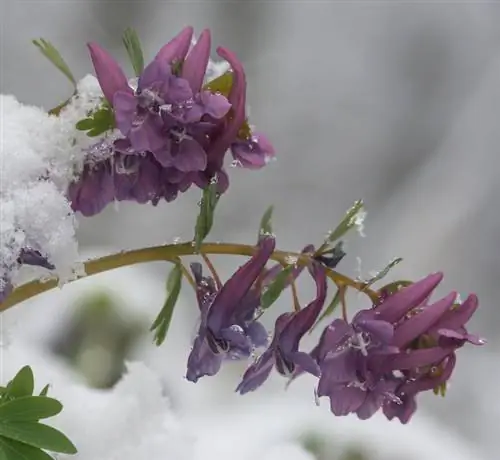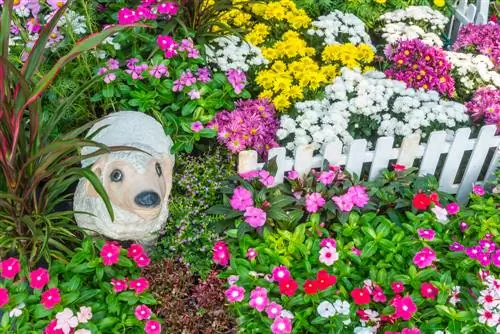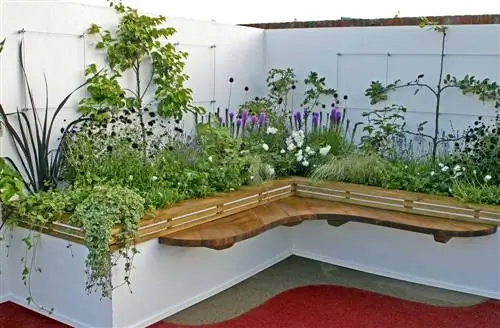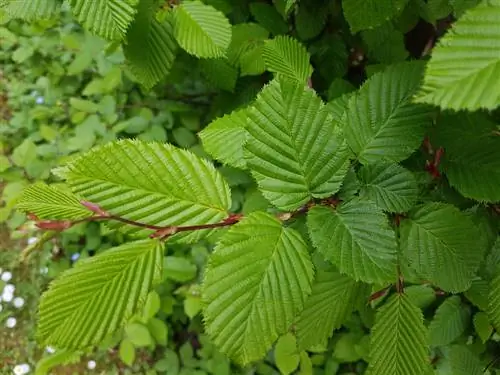- Author admin [email protected].
- Public 2023-12-16 16:46.
- Last modified 2025-01-23 11:20.
In the natural garden, the wild larkspur is there when semi-shady to shady locations need to be decoratively planted. On the edge of the wood or in niches with little light on the balcony, the multi-faceted Corydalis genus delights us with pretty flowers above delicate decorative leaves. The following answers to frequently asked questions explain precisely and practically how uncomplicated cultivation is.
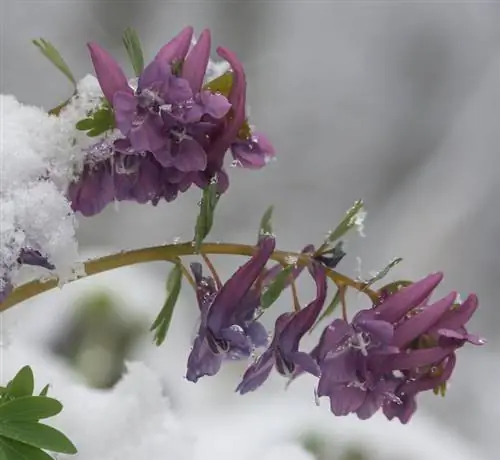
How do you care for larkspur in the garden?
Larkspur is a versatile perennial with showy flowers in red, blue or yellow. The plants prefer partially shaded to shady locations with fresh, moist, nutrient-rich soil. Care includes sufficient watering, initial fertilization and, if necessary, winter protection.
Planting larkspur correctly
September and October are planting times for larkspurs. This applies equally to tubers and container plants. Create small pits at a distance of 20-30 cm in the humus-rich, moist and nutrient-rich soil in a partially shaded location. For finished young plants, the hole should be about twice as large as the root ball. Plant Corydalis tubers, placing them 5-8 cm deep in the soil. You improve the starting conditions for these perennials if the soil is enriched with compost (€12.00 on Amazon) and horn shavings. At the end, please water and mulch with leaves, bark mulch or lawn clippings.
Care tips
Adequate water supply is the mainstay of the correct care of larkspur. Water the wild perennial regularly, as drought stress significantly impairs growth and abundance of flowers. In contrast, the native plant can do without fertilizer in the optimal location. Starting fertilization with compost is still welcome. If you cut out withered flower stalks regularly, the splendor of the colors will last even longer. The leaves are only cut off when they are completely absorbed. Until then, the tuber absorbs the remaining nutrients to create a depot. As winter protection, simply leave the autumn leaves lying there and spread a few pine fronds over them.
Which location is suitable?
The majority of larkspur species and varieties prefer a partially shaded location. Various varieties are not even afraid of shady locations, such as the fern larkspur (Corydalis cheilanthifolia) or the medium larkspur (Corydalis intermedia), which is native to the ravine forests of the Balkans. Other varieties thrive just as well in a sunny spot if there is sufficient soil moisture. Therefore, when purchasing tubers and young plants, ask carefully in order to purchase the ideal perennial for the intended location.
What soil does the plant need?
The diverse larkspurs agree that they prefer fresh, moist, nutrient-rich and well-drained soil. When it comes to soil acidity, desires differ, of course. Corydalis, such as the Kashmir larkspur (Corydalis cashmeriana), are available as companions for rhododendrons in acidic soil. The natural perennials predominantly want to be located in neutral to slightly alkaline soil.
When is flowering time?
The multifaceted variety of species and varieties offers us Corydalis beauties that, thanks to different flowering times, ensure the perfect change of scenery in the bed. We have put together the flowering times of the most important larkspur species for beds and balconies here for you:
- Fingered Lechenspur (Corydalis solida): flowering period from March to April
- Blue Larkspur (Corydalis elata): flowering period from May to July
- Yellow Larkspur (Corydalis lutea): flowering period from May to October
Take a close look at the pretty flowers. These have two mirror-like halves along a single axis of symmetry. The tubular, individual flowers, up to 25 millimeters long, sit close together on an unbranched flower stalk in beautiful shades of red, blue and yellow.
Cut larkspur correctly
If you cut off the dead stems regularly, this measure will extend the flowering period. This also prevents excessive self-seeding. To do this, leave only a few flower stalks at the end of the flowering period, as experience has shown that the mother plants are quite short-lived. Please only prune close to the ground when the leaves have completely yellowed.
Watering larkspur
Water is the elixir of life for the larkspur. Therefore, water the wild perennial abundantly and regularly without causing waterlogging. There is a greater need for watering in potted plants than in fresh, moist garden soil. Therefore, check with your finger every 1-2 days to see whether the substrate has dried out. Add regular tap water to the root area until the saucer fills up.
Fertilize larkspur properly
Under ideal location conditions in nutrient-rich garden soil, a starter fertilization with compost (€12.00 at Amazon) and horn shavings is sufficient. Bark humus, guano granules or horse manure also get the larkspur going. Work in the organic material and add water. If the wild perennial thrives in the pot, apply a liquid fertilizer every 4 weeks from May until the end of the flowering period.
Wintering
As part of the European flora, the larkspur is used to suffering in winter. Even bitter frost cannot harm the wild perennial. However, constant moisture can cause the tubers to rot. We therefore recommend leaving fallen leaves in autumn and fixing them with coniferous twigs. For reasons of caution, please cover planters with jute or foil and slide a wooden block underneath.
Propagate Larkspur
Tumer-forming larkspur species, such as Corydalis intermedia, produce daughter tubers or bulbs. Dig up these perennials in the fall to cut off the small cuttings with a sharp, disinfected knife. You can either plant the nodules straight away in the garden soil or nurture the tiny plants in the pot first. Ball-forming species, such as Corydalis solida, are ideal for propagation by division. Remove the root ball from the soil in the fall and use the spade to divide it into two or more segments. Plant these sections in the compost prepared soil at the new location and water generously.
Is Larkspur poisonous?
Lark spur is classified as a poisonous ornamental plant. The reason for this is the toxic ingredients, which are particularly concentrated in the tubers and rhizomes. The toxins are also contained in leaves, shoots and flowers. Therefore, consider growing Corydalis only out of the reach of children and pets. Until planting, please store the tubers so that they cannot be confused with onions or vegetables.
Beautiful varieties
- Blue Summit: The premium variety impresses with steel blue flowers on panicles up to 8 cm long; Growth height 30-40 cm
- Yellow Larkspur: Outstanding, very adaptable perennial with yellow flowers from May to October; Growth height 25-35 cm
- GP Bakker: The magnificent spring bloomer boasts red flowers over filigree leaves from March; Growth height 15-20 cm
- Blue Heron: Blue flowering larkspur with wintergreen, fern-like leaves for beds and pots; Growth height 20-25 cm
- Canary Feathers: Abundantly blooming ornamental perennial with canary-yellow flowers and fine foliage; Growth height 30 cm

